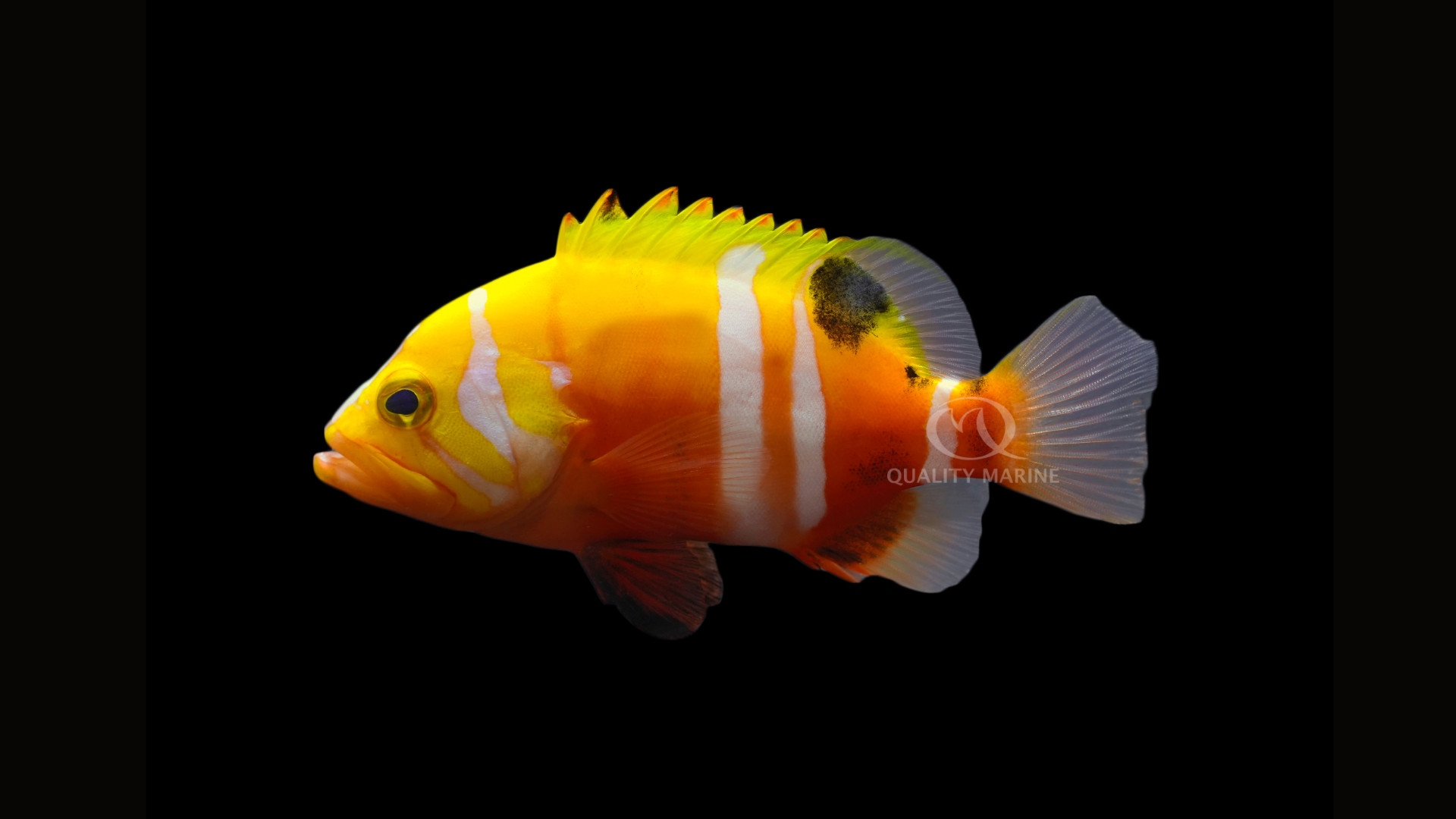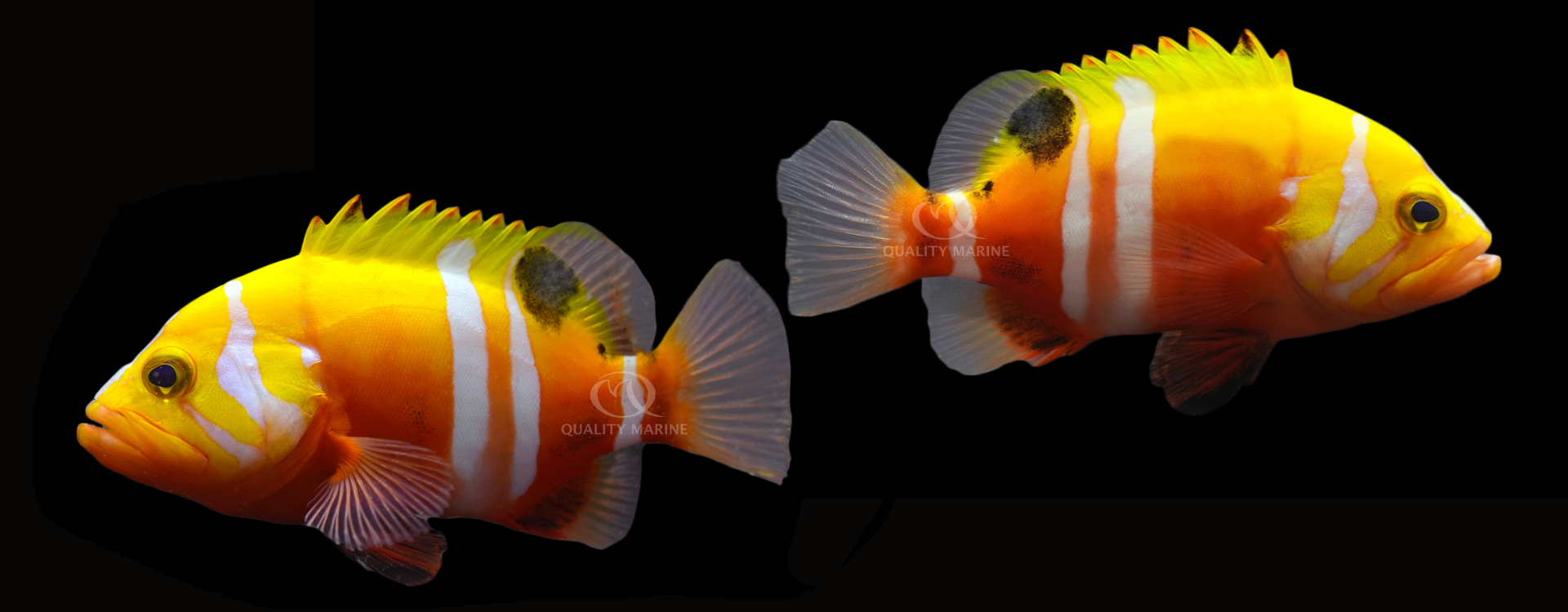Neptune, God Of The Depths

If you've sat at enough sushi restaurants, you've likely tried or seen a fish known as Shimahata. It can be found on occasion at fish markets throughout its natural range, throughout much of the tropical Pacific, ranging from southern Japan in the north to Fiji in the south, and Malaysia in the east to Hawaii & Tahiti in the west. As uncommon as this fish is in these markets, it is, unfortunately, even more rarely seen in local fish stores. In fact, the first public aquarium ever to display this fish only did so in 2009! The Neptune Grouper's rarity stems from its natural habitat. This fish lives in very deep water, very deep. They have been caught from 260 feet down, to the recorded record depth of 820 feet, in Tahiti.
This means it doesn't show up on menus very often, let alone your Local Fish Store. All this being said, today, here at Quality Marine, we have one. It is perhaps the first one here in over a decade. The rest of the world has several names for this fish: in Malaysia it is known as the Garish Hind, or Garish Rockcod, in Hawaii, they call it the Goldbar Grouper, the Christmas Islanders call it the Japanese Cod, in France it is known as Vieille Voyant. Here in North America, it is known as the Neptune Grouper, Cephalopholis igarashiensis, although it is almost never seen here alive.
Wherever you're from and whatever you call it, Cephalopholis igarashiensis is a member of the family Serranidae which most of us know better as the family of Groupers and Fairy Basslets. There are lots of gorgeous fish in this family, and a huge range of sizes. Usually the biggest ones (generally the Groupers) are most beautiful in their juvenile forms, and the Fairy Basslets stay small and beautiful throughout their lives. The Neptune Grouper is a sweet blend of these two; in that it gets big, but not too big, and goes from gorgeous to stunning throughout its life.
This fish has a record size of almost 18 inches, but the adult size is commonly thought to be more like ten to twelve inches. This is still a large fish by aquarium standards, but seeing as how some other fish in this family get into measurements that require feet rather than inches, this is a very “keepable” fish. We suggest a keeping them in a large tank; something in the range of 180 gallons and 6 feet long, and obviously, bigger is better. Filtration should be overly strong as this is a large predator and used to big meals that will obviously produce a lot of waste. Lighting is somewhat immaterial, though as this fish comes from incredibly deep, dark water, the high-power lights that are common in reef aquariums will cause this animal undue stress

The groupers in the genus Cephalopholis can be put into aquariums that also contain coral. They are very unlikely to physically bother sessile (stuck in one place) invertebrates. However, as previously referenced, these fish do produce a lot of waste and nutrient spikes could be detrimental to your corals if they are not chosen carefully, or the filtration vastly overpowered, or both. The other caveat is that groupers are hungry, and they are hungry mostly for fish, crabs, shrimp and pretty much anything that moves and can fit in their oversized mouths. They can actually eat fish that are almost a full third as long as the Neptune Grouper. This means that if your Neptune Grouper is nine inches long, every three-inch fish in the aquarium looks like food to it.
The groupers are not aggressive fish in general, though some will pick a cave and they may be territorial about that specific space. When choosing tankmates, we suggest picking corals that can deal with, or even like some fluctuation in nutrient levels, there are lots of gorgeous soft corals and polyps that fit this bill. Things like Toadstools, Xenia, Zoas and Cloves make great choices. When picking fish, bigger is better, though some smaller fish might be ok as long as the tank is very large, and the fish are very adept swimmers. Avoid plodding fish like Cardinals and Clowns (unless they have a really big aggressive anemone to hide in). You may also want to avoid fish like large Puffers that are likely to pick on the more sedentary fish like the Neptune Grouper. Large predator fish are good tankmates. Scorpions, Lionfish, Triggers all makes for cool displays; if you want to have some smaller fish, we suggest things like Fusilers that are on the bigger size for “dither fish” and swim very fast. Bear in mind that anything on the smaller size runs the risk of becoming food. We've seen other Cephalopholis kept with Snowflake Eels long term in tanks that had plenty of caves for everyone to share.
Feeding the Neptune Grouper is pretty straight forward as they will eat a lot of stuff. Rely heavily on thawed, marine meats. Silversides, mussel, clam, prawn and market fish are all great foods. Use a variety of foods, and feed infrequently. Like all the other groupers kept in captivity, initial feeding sometimes takes a feeding stick, but Cephalopholis generally learn to recognize humans as a source of food fairly quickly, and many will eat right from your hands in short order (which we do not recommend for safety reasons but is fun to see). After your fish become accustomed to these foods aquarists should also introduce a large sinking pellet food to their diet, for their elevated protein levels and broad spectrum of nutrients.
For those of you with a big enough tank, suitable tankmates, and the budget, the Neptune Grouper offers the chance to have a “Once in a Lifetime” fish. These are among the most uncommon and gorgeous fish you can find in the marine aquarium hobby, and this is not likely to ever change. If you're ready for your Holy Grail fish, have your LFS call Quality Marine, today. (Article posted 03-06-2023)
https://www.fishbase.se/summary/5366